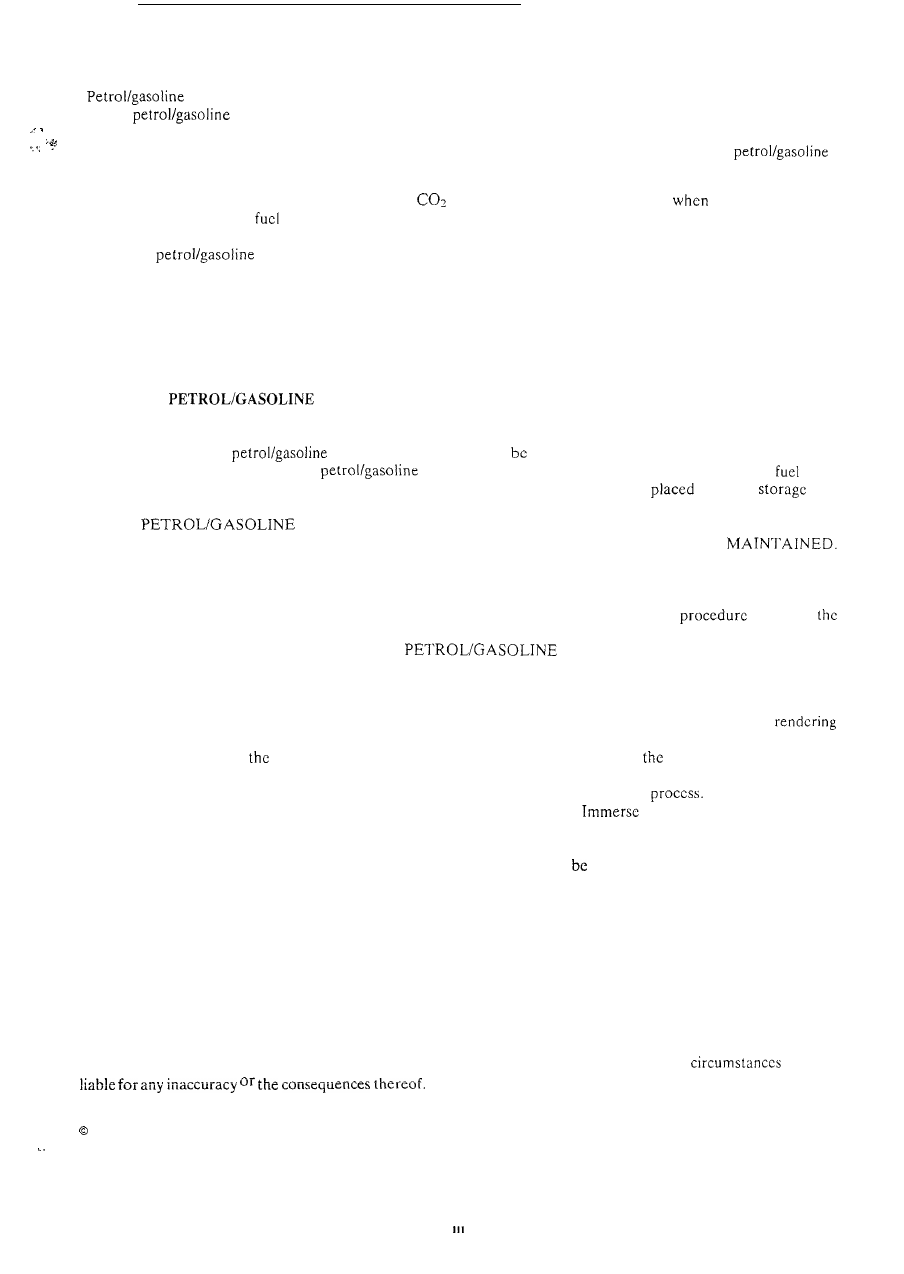Defender 90 / 110 / 130. Manual - part 20

GENERAL
vapour
is highly flammable and in confined spaces is also very explosive and toxic.
When
evaporates it produces
150
times its own volume
in vapour, which when diluted with air
becomes a readily ignitable mixture. The vapour is heavier than air and
will always fall to the lowest level. It can
readily be distributed throughout a workshop by air current, consequently, even a small spillage of
is
potentially very dangerous.
Always have a fire extinguisher containing FOAM
GAS, o r POWDER close at hand
handling
or draining
fuel, or when dismantling
systems and in areas where fuel containers arc stored.
Always disconnect the vehicle battery B E F O R E carrying out dismantling
or draining work on a fuel system.
Whenever
is being handled, drained or stored, o r when fuel systems are being dismantled all forms of
ignition must be extinguished or removed, any head-lamps used must be flameproof and kept clear
of spillage.
,
.
N O ONE S H O U L D B E PERMITTED
TO
REPAIR COMPONENTS ASSOCIATED WITH PETROL/
GASOLINE WITHOUT FIRST HAVING H A D SPECIALIST TRAINING.
FUEL TANK DRAINING
WARNING:
MUST NOT
BE EXTRACTED OR DRAINED FROM ANY VEHICLE
WHILST
IT
IS STANDING OVER A PIT.
Draining
or extracting
from vehicle fuel tank must
carried out in a well ventilated area.
The receptacle used to contain the
must be more than adequate for the full amount
of
to be
extracted or drained. The receptacle should be clearly marked with its contents, and
in a safe
area
which meets the requirements of local authority regulations.
WHEN
HAS BEEN EXTRACTED O R DRAINED FROM A FUEL TANK
THE
PRECAUTIONS GOVERNING NAKED LIGHTS A N D JGNITION SOURCES S H O U L D BE
- -
FUEL TANK REMOVAL
On vehicles where
the fuel line is sccurcd to the fuel tank outlet by a spring steel clip,
it
is recommended
that
such
clips are released before the fuel line is disconnected or the fuel tank unit
is removed.
This
will
avoid
possibility of residual petrol fumes in the fuel tank being ignited when the clips are released.
As an added precaution fuel tanks should have a
VAPOUR warning label attached to them
as
soon as they are removed from the vehicle.
FUEL
TANK
REPAIR
Under
no circumstances should a repair to any tank involving heat treatment bc carried out without first
t h e
tank SAFE, by
using one of the following methods:
STEAMING: With
filler cap and tank unit removed, empty the tank. Steam
tank for at least two hours
with low pressure steam. Position the tank
so that condensation can drain away freely, ensuring that any
sediment and sludge not volatised by the steam, is washed out during the steaming
BOILING: With the filler cap and tank unit removed, empty the tank.
the tank completely
in boiling
water containing an effective alkaline degreasing agent o r a detergent, with
t h e water filling and
also
surrounding the tank for at least two hours.
After steaming o r boiling a signed and dated label to this effect should
attached to the tank.
SPECIFICATION
Purchasers are advised that the specification details set out
in
this Manual apply to
a range of vehicles and not to any
one. For the specification of a particular vehicle, purchasers should consult their Distributor o r Dealer.
The Manufacturers reserve the right to vary their specifications with
or without notice, and at such times and
in
such
manner as they think fit. Major as well as minor changes may be involved in accordance with the Manufacturer’s
policy
of constant product improvement.
Whilst every effort is made to ensure the accuracy
of the particulars contained
in
this Manual, neither the
Manufacturer
nor the Distributor or Dealer, by whom this Manual is supplied, shall
i n
any
be held
COPY RIGHT
Land Rover Limited
1984
All rights reserved. No part
of this publication may be produced, stored
in
a retrieval system or transmitted in any
form, electronic, mechanical, photocopying, recording or other means without prior written permission of Land
Rover Limited, Service Department, Solihull, England.
...